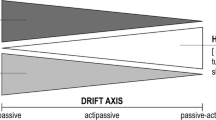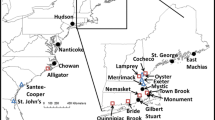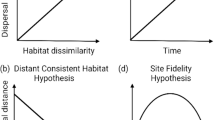Abstract
Fish movements have been extensively studied and variously described for many years and several conceptual frameworks have since been proposed to help organize and understand these movements. Frameworks include ecological scale, the restricted movement paradigm, partial migration, dynamic landscape model, and riverscape approach. We blended reviews of selected frameworks and past studies in the Driftless Area of the upper Midwestern United States to advance an understanding of stream-resident salmonid movements. Past studies examined feeding and exploratory, seasonal migration and dispersal movements using underwater videography, radiotelemetry, capture–recapture method, and genetics method at various spatiotemporal and ontogenetic scales. Movements were complex and changed over the course of ontogeny. Most movement was at the youngest ages and smallest sizes and again at very large sizes as a result of exploratory behavior and feeding movements to seek better physical habitat conditions (e.g., deeper pool habitat) or to avoid competitive or predatory interactions with other salmonids. In between, adult-sized salmonids were mostly sedentary as suggested by the restricted movement paradigm. Restricted movement was likely due to ideal environmental conditions provided by a combination of groundwater-fed springs supporting good baseflow and cold temperatures, productive streams with abundant invertebrate prey, and diverse physical habitat conditions in a small spatial area. Thus, there was little evidence of seasonal migration to fulfill seasonal resource needs as predicted by the dynamic landscape model. Rather, a more general riverscape model best describes the partial migration of Driftless Area salmonid populations. In this model, stream reaches provide adequate seasonal habitat facilitating mostly sedentary adults, but with some inter-reach dispersal at juvenile ages and at the largest adult sizes.
Access this chapter
Tax calculation will be finalised at checkout
Purchases are for personal use only
Similar content being viewed by others
References
Aarestrup K, Jepsen N, Thorstad EB (2018) Brown trout on the move—migration ecology and methodology. In: Lobón-Cerviá J, Sanz N (eds) Brown trout: biology, ecology and management. Wiley, Hoboken, NJ, pp 401–444
Allan JD (1995) Stream ecology: structure and function of running waters. Chapman and Hall, New York
Alp A, Akyüz A, Özcan M et al (2018) Assessment of movements and habitat use of Salmo opimus in Fırnız stream, river Ceyhan of Turkey using radio telemetry techniques. Environ Biol Fish 101:1613–1624
Annear T, Chisholm I, Beecher H et al (2004) Instream flows for riverine resource stewardship, revised edition. Instream Flow Council, Cheyenne, WY
Aparicio E, Rocaspana R, de Sostoa A et al (2018) Movements and dispersal of brown trout (Salmo trutta Linnaeus, 1758) in Mediterranean streams: influence of habitat and biotic factors. PeerJ 6:e5730
Barry J, McLoone P, Fitzgerald CJ et al (2020) The spatial ecology of brown trout (Salmo trutta) and dace (Leuciscus leuciscus) in an artificially impounded riverine habitat: results from an acoustic telemetry study. Aquat Sci 82:63
Bélanger G, Rodríguez MA (2002) Local movement as a measure of habitat quality in stream salmonids. Environ Biol Fish 64:155–164
Berry O, Tocher MD, Sarre SD (2004) Can assignment tests measure dispersal? Mol Ecol 13:551–561
Budy P, Thiede GP, Lobón-Cerviá J et al (2013) Limitation and facilitation of one of the world’s most invasive fish: an intercontinental comparison. Ecology 94:356–367
Carlson AK, French WE, Vondracek B et al (2016) Brown trout growth in Minnesota streams as related to landscape and local factors. J Freshwat Ecol 31:421–429
Chapman BB, Skov C, Hulthén K et al (2012) Partial migration in fishes: definitions, methodologies and taxonomic distribution. J Fish Biol 81:479–499
Clapp DF, Clark RD Jr, Diana JS (1990) Range, activity, and habitat of large, free-ranging brown trout in a Michigan stream. Trans Am Fish Soc 119:1022–1034
Cochran-Biederman JL, Vondracek B (2017) Seasonal feeding selectivity of brown trout Salmo trutta in five groundwater-dominated streams. J Freshwater Ecol 32:653–673
Cote WE Reinertsen DL Killey MM (1971) Guide leaflet, geological science field trip, Galena Area: Jo Daviess County Illinois and Lafayette County, Wisconsin: Galena 15-Minute Quadrangle, Cuba City and New Diggings 7.5 minute Quadrangles: Illinois State Geological Survey, Guide Leaflet 1971c, p 36
Crisp DT (1993) Population densities of juvenile trout (Salmo trutta) in five upland streams and their effects upon growth, survival and dispersal. J Appl Ecol 30:759–771
Cucherousset J, Ombredane D, Charles K et al (2005) A continuum of life history tactics in a brown trout (Salmo trutta) population. Can J Fish Aquat Sci 62:1600–1610
Daufresne M, Capra H, Gaudin P (2005) Downstream displacement of post-emergent brown trout: effects of development stage and water velocity. J Fish Biol 67:599–614
Davis CD, Epps CW, Flitcroft RL et al (2018) Refining and defining riverscape genetics: how rivers influence population genetic structure. WIREs Water 5:e1269. https://doi.org/10.1002/wat2.1269. Accessed 5 June 2021
Dermond P, Thomas SM, Brodersen J (2017) Environmental stability increases relative individual specialization across populations of an aquatic top predator. Oikos 127:297–305
Diana JS, Hudson JP, Clark RD Jr (2004) Movement patterns of large brown trout in the mainstream Au Sable River, Michigan. Trans Am Fish Soc 133:34–44
Diebel MW, Fedora M, Cogswell S et al (2014) Effects of road crossings on habitat connectivity for stream-resident fish. River Res Appl 31:1251–1261
Dieterman DJ, Hoxmeier RJH (2011) Demography of juvenile and adult brown trout in streams of southeastern Minnesota. Trans Am Fish Soc 140:1642–1656
Dieterman DJ, Thorn WC, Anderson CS (2004) Application of a bioenergetics model for brown trout to evaluate growth in southeast Minnesota streams. Investigational Report 513, Division of Fisheries and Wildlife, Minnesota Department of Natural Resources, St. Paul, MN
Dieterman DJ, Thorn WC, Anderson CS et al (2006) Summer habitat associations of large brown trout in southeastern Minnesota streams. Investigational Report 539, Division of Fisheries and Wildlife, Minnesota Department of Natural Resources, St. Paul, MN
Dieterman DJ, Hoxmeier RJH, Staples DF (2012) Factors influencing growth of individual brown trout in three streams of the upper Midwestern United States. Ecol Freshwat Fish 21:483–493
Dieterman DJ, Thorn WC, Anderson CS (2018) Winter habitat selection by large Brown Trout in streams with and without habitat rehabilitation. N Am J Fish Manag 38:253–266
Dieterman DJ, Hoxmeier RJH, Roloff J et al (2020) Use of long-term (40+ year) trend data to evaluate management actions on brown trout, Salmo trutta, populations in groundwater-fed streams. Fish Manag Ecol 27:551–566
Dingle H, Drake VA (2007) What is migration? BioScience 57:112–121
Elsdon TS, Wells BK, Campana SE et al (2008) Otolith chemistry to describe movements and life-history parameters of fishes: hypotheses, assumptions, limitations and inferences. Oceanogr Mar Biol 46:297–330
Erős T, Lowe WH (2019) The landscape ecology of rivers: from patch-based to spatial network analyses. Curr Landsc Ecol Rep 4:103–112
Fausch KD, Torgersen CE, Baxter CV et al (2002) Landscapes to riverscapes: bridging the gap between research and conservation of stream fishes. BioScience 52:483–498
Ferguson A, Reed TE, Cross TF et al (2019) Anadromy, potamodromy and residency in brown trout Salmo trutta: the role of genes and the environment. J Fish Biol 95:692–718
Forman RTT, Godron M (1986) Landscape ecology. Wiley, New York
French WE, Vondracek B, Ferrington LC Jr et al (2016) Winter diet of brown trout Salmo trutta in groundwater-dominated streams: influence of environmental factors on spatial and temporal variation. J Fish Biol 89:2449–2464
Galinat AG, Davis JL, Simpson G (2020) Short-term movement and survival of resident brown trout in response to instream habitat manipulation. J FisheriesSciences.com 14(3):001–006
Goldscheider N, Chen Z, Auler AS et al (2020) Global distribution of carbonate rocks and karst water resources. Hydrogeol J 28:1661–1677
Gowan C, Young MK, Fausch KD et al (1994) Restricted movement in resident stream salmonids: a paradigm lost? Can J Fish Aquat Sci 51:2626–2637
Grant GC (1999) Growth, spawning behavior and feeding strategies of trout in a small Midwestern stream. Dissertation, University of Minnesota
Hanski I (1999) Metapopulation ecology. Oxford University Press, Oxford
Hoffman JC (2016) Tracing the origins, migrations and other movements of fishes using stable isotopes. In: Morais P, Daverat F (eds) An introduction to fish migration. CRC, Boca Raton, FL, pp 169–196
Hoxmeier RJH, Dieterman DJ (2013) Seasonal movement, growth, and survival of brook trout in sympatry with brown trout in Midwestern US streams. Ecol Freshwat Fish 22:530–542
Hoxmeier RJH, Dieterman DJ (2016) Long-term population demographics of native brook trout following manipulative reduction of an invader. Biol Invasions 18:2911–2922
Hoxmeier RJH, Dieterman DJ (2019) Natural replacement of invasive brown trout by brook charr in an upper Midwestern United States stream. Hydrobiologia 840:309–317
Hoxmeier RJH, Dieterman DJ, Miller LM (2015) Brook trout distribution, genetics, and population characteristics in the Driftless Area of Minnesota. N Am J Fish Manag 35:632–648
Jones P, Closs G (2018) The introduction of brown trout to New Zealand and their impact on native fish communities. In: Lobón-Cerviá J, Sanz N (eds) Brown trout: biology, ecology and management. Wiley, Hoboken, NJ, pp 545–567
Jonsson B, Jonsson N (2011) Ecology of Atlantic salmon and brown trout: habitat as a template for life histories. Fish and fisheries series 33. Springer, New York
Kelly B (2020) Spatial distribution and ecological relationships of stream fishes in Iowa’s Driftless Area. MS thesis, Iowa State University
Kelly B, Siepker MJ, Weber MJ (2021) Factors associated with detection and distribution of native brook trout and introduced brown trout in the Driftless Area of Iowa. Trans Am Fish Soc 150:388–406
Knouft JH, Spotila JR (2002) Assessment of movements of resident stream brown trout, Salmo trutta L., among contiguous sections of stream. Ecol Freshwat Fish 11:85–92
Kwak TJ, Waters TF (1997) Trout production dynamics and water quality in Minnesota streams. Trans Am Fish Soc 126:35–48
Levin SA (1992) The problem of pattern and scale in ecology. Ecology 73:1943–1967
McCullough DR (1996) Metapopulations and Wildlife Conservation. Island Press, Washington, DC
McFadden JT, Cooper EL (1962) An ecological comparison of six populations of brown trout (Salmo trutta). Trans Am Fish Soc 91:53–62
McManamay RA, Bevelhimer MS, Kao S-C (2014) Updating the US hydrologic classification: an approach to clustering and stratifying ecohydrologic data. Ecohydrology 7:903–926
Meraner A, Gandolfi A (2018) Genetics of the genus Salmo in Italy: evolutionary history, population structure, molecular ecology and conservation. In: Lobón-Cerviá J, Sanz N (eds) Brown trout: biology, ecology and management. Wiley, Hoboken, NJ, pp 65–102
Meyers LS, Thuemler TF, Kornely GW (1992) Seasonal movements of brown trout in northeast Wisconsin. N Am J Fish Manag 12:433–441
Miller MA (2016) An assessment of barriers to fish passage in streams and rivers of the Driftless Area ecoregion caused by roadway culverts and bridges. Final Report for US Fish and Wildlife Service grant F10AP00093-0001-00W4, Wisconsin Department of Natural Resources, Madison, WI
Miller LM, Dieterman DJ, Hoxmeier J (2019) Reproductive dynamics of a native brook trout population following removal of non-native brown trout from a stream in Minnesota, north-central USA. Hydrobiologia 840:49–61
Mitro MG, Lyons JD, Stewart JS et al (2019) Projected changes in brook trout and brown trout distribution in Wisconsin streams in the mid-twenty-first century in response to climate change. Hydrobiologia 840:215–226
Newman RM, Waters TF (1989) Differences in brown trout (Salmo trutta) production among contiguous sections of an entire stream. Can J Fish Aquat Sci 46:203–213
Nicola GG, Almodóvar A (2002) Reproductive traits of stream-dwelling brown trout Salmo trutta in contrasting neighbouring rivers of central Spain. Freshwat Biol 47:1353–1365
Nicola GG, Almodóvar A, Elvira B (2009) Influence of hydrologic attributes on brown trout recruitment in low-latitude range margins. Oecologia 160:515–524
Pine WE, Hightower JE, Coggins LG et al (2012) Design and analysis of tagging studies. In: Zale AV, Parrish DL, Sutton TM (eds) Fisheries techniques, 3rd edn. American Fisheries Society, Bethesda, MD, pp 521–572
Potter KW (2019) Hydrology of the Driftless Area. In: Dauwalter DC (ed) A look back at Driftless Area science to plan for resiliency in an uncertain future. Special publication of the 11th annual Driftless Area symposium, La Crosse, pp 15–19. https://www.tu.org/wp-content/uploads/2019/02/Driftless_Area_Science.pdf. Accessed 14 May 2021
Rabeni CF, Jacobson RB (1999) Warmwater streams. In: Kohler CC, Hubert WA (eds) Inland fisheries management in North America, 2nd edn. American Fisheries Society, Bethesda, MD, pp 505–528
Rasmussen JE, Belk MC (2017) Individual movement of stream fishes: Linking ecological drivers with evolutionary processes. Rev Fish Sci Aquacult 25:70–83
Rasmussen GH, Pedersen S (2018) Sea trout (Salmo trutta L.) in Denmark. In: Lobón-Cerviá J, Sanz N (eds) Brown trout: biology, ecology and management. Wiley, Hoboken, NJ, pp 483–521
Real LA, Brown JH (1991) Foundations in ecology: classic papers with commentaries. University of Chicago Press, Chicago, IL
Rodríguez MA (2002) Restricted movement in stream fish: The paradigm is incomplete not lost. Ecology 83:1–13
Roni P (2019) Does river restoration increase fish abundance and survival or concentrate fish? The effects of project scale, location, and fish life history. Fisheries 44:7–19
Saint-Pé K (2019) In situ quantification of brown trout movements. Doctoral dissertation, Paul Sabatier University, Toulouse III, France
Sanz N (2018) Phylogeographic history of brown trout: a review. In: Lobón-Cerviá J, Sanz N (eds) Brown trout: biology, ecology and management. Wiley, Hoboken, NJ, pp 17–63
Schlosser IJ, Angermeier PL (1995) Spatial variation in demographic processes in lotic fishes: conceptual models, empirical evidence, and implications for conservation. In: Nielsen JL (ed) Evolution and the aquatic ecosystem: defining unique units in population conservation, Symposium 17. American Fisheries Society, Bethesda, MD, pp 360–370
Spiegel O, Leu ST, Bull CM et al (2017) What’s your move? Movement as a link between personality and spatial dynamics in animal populations. Ecol Lett 20:3–18
Splinter DK (2019) The Driftless Area—a physiographic setting. In: Dauwalter DC (ed) A look back at Driftless Area science to plan for resiliency in an uncertain future. Special publication of the 11th annual Driftless Area symposium, La Crosse, pp 5–8. https://www.tu.org/wp-content/uploads/2019/02/Driftless_Area_Science.pdf. Accessed 14 May 2021
Thorn WC, Anderson CS (1999) A provisional classification of Minnesota rivers with associated fish communities. Special publication 153, Minnesota Department of Natural Resources, St. Paul, MN
Thorn WC, Anderson CS, Lorenzen WE et al (1997) A review of trout management in southeast Minnesota streams. N Am J Fish Manag 17:860–872
Vondracek B, Blann KL, Cox CB et al (2005) Land use, spatial scale, and stream systems: lessons from an agricultural region. Environ Manag 36:775–791
Wang L, Lyons J, Kanehl P (2003) Impacts of urban land cover on trout streams in Wisconsin and Minnesota. Trans Am Fish Soc 132:825–839
Weigel DE, Sorensen PW (2001) The influence of habitat characteristics on the longitudinal distribution of brook, brown, and rainbow trout in a small Midwestern stream. J Freshwat Ecol 16:599–613
Weiss JL (2000) Movement and population turnover of brown trout in southeastern Minnesota streams and a comparison of three methods for estimating exploitation. Completion Report for F-29-R-19, Job 506, Section of Fisheries, Minnesota Department of Natural Resources, St. Paul, MN
W.L.C (1937) Investigations on salmon and sea trout. Sci Prog 32(125):139–141. http://www.jstor.org/stable/43412033. Accessed March 24, 2021
Wood DM, Welsh AB, Petty JT (2018) Genetic assignment of brook trout reveals rapid success of culvert restoration in headwater streams. N Am J Fish Manag 38:991–1003
Author information
Authors and Affiliations
Corresponding author
Editor information
Editors and Affiliations
Rights and permissions
Copyright information
© 2024 This is a U.S. government work and not under copyright protection in the U.S.; foreign copyright protection may apply
About this chapter
Cite this chapter
Dieterman, D.J., Miller, L.M., Hoxmeier, R.J.H. (2024). Understanding Stream-Resident Salmonid Movements in Groundwater-Fed Streams of the Driftless Area (USA). In: Lobon-Cervia, J., Budy, P., Gresswell, R. (eds) Advances in the Ecology of Stream-Dwelling Salmonids. Fish & Fisheries Series, vol 44. Springer, Cham. https://doi.org/10.1007/978-3-031-44389-3_9
Download citation
DOI: https://doi.org/10.1007/978-3-031-44389-3_9
Published:
Publisher Name: Springer, Cham
Print ISBN: 978-3-031-44388-6
Online ISBN: 978-3-031-44389-3
eBook Packages: Biomedical and Life SciencesBiomedical and Life Sciences (R0)




